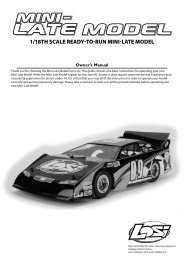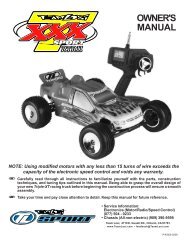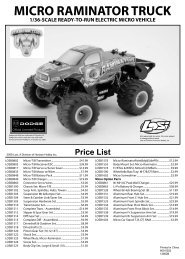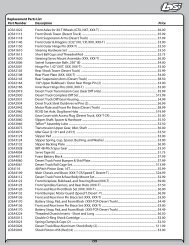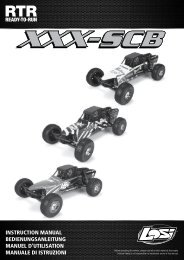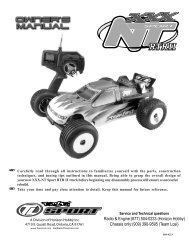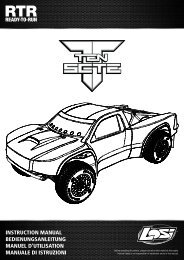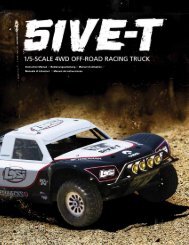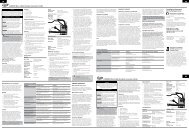1/10 XXX-SCT Brushless - English - Horizon Hobby
1/10 XXX-SCT Brushless - English - Horizon Hobby
1/10 XXX-SCT Brushless - English - Horizon Hobby
You also want an ePaper? Increase the reach of your titles
YUMPU automatically turns print PDFs into web optimized ePapers that Google loves.
EN<br />
Dynamite Tazer 3300Kv 4-Pole <strong>Brushless</strong> Motor (DYN4942)<br />
Precautions<br />
• Never touch moving parts.<br />
• Never disassemble while the batteries are installed.<br />
• Always let parts cool before touching.<br />
Adjusting the Slipper<br />
Turn the 1/4" (3mm) adjustment nut clockwise (to the right) to reduce the slip<br />
or counterclockwise (to the left) to increase the slip.<br />
Setting the Gear Mesh<br />
The gear mesh has already been set at the factory. Setting it is only necessary when changing<br />
motors or gears.<br />
Proper gear mesh (how gear teeth meet) is important to the performance of the vehicle. When<br />
the gear mesh is too loose, the spur gear could be damaged by the pinion gear of the motor. If<br />
the mesh is too tight, speed could be limited and the motor and ESC will overheat.<br />
GEARING<br />
Your vehicle has been equipped with the optimal gearing for the stock platform. It offers an<br />
ideal balance between speed, power and efficiency. Should you decide to customize your<br />
vehicle with optional batteries or motors, it may be necessary for you to change the pinion or<br />
spur gear.<br />
Installing a pinion gear with less teeth or a spur gear with more teeth will provide greater<br />
torque but will reduce top speed. Likewise, a pinion gear with more teeth or a spur gear with<br />
fewer teeth will reduce torque and increase top speed. Care should be taken when installing<br />
larger pinion gears as this can “overgear” the vehicle, resulting in overheating of the motor<br />
and ESC. When testing different gearing options, pay close attention to the temperature of<br />
the motor and speed control to ensure you are operating within the temperature range of the<br />
components. The motor or ESC should never be so hot that it cannot be touched. If temperatures<br />
are too hot, a different gearing combination with a lower pinion gear and/or higher spur<br />
gear is suggested.<br />
CHANGING THE PINION GEAR/GEAR RATIO<br />
1. Unscrew the gear cover screws and remove the gear cover.<br />
2. Loosen the motor screws and slide the motor back.<br />
3. Loosen the set screw and remove the installed pinion gear.<br />
4. Place the new pinion on the end of the motor shaft so the set screw is located<br />
over the flat on the shaft.<br />
5. Position it so the teeth line up with the spur gear and secure the pinion by tightening<br />
the set screw.<br />
6. Set the gear mesh.<br />
7. Reinstall the gear cover.<br />
1. Unscrew the gear cover screws and remove the gear cover.<br />
2. Loosen the motor screws and slide the motor back.<br />
3. Put a small piece of paper between the pinion and spur gears.<br />
4. Push the gears together while tightening the motor screws.<br />
5. Remove the paper. Check the mesh at 3–5 different locations around<br />
the spur gear for a small amount of movement.<br />
6. Reinstall the gear cover.<br />
Troubleshooting Guide<br />
If after reading below you cannot resolve your problem,<br />
contact the appropriate <strong>Horizon</strong> product support center.<br />
Steering servo operates but the motor does not run<br />
• Reprogram the ESC by following the programming instructions.<br />
• Confirm the ESC is properly connected to the throttle channel on the receiver.<br />
• Damaged motor: Test motor independently, repair or replace as needed.<br />
• Vehicle battery voltage is low: Charge as needed.<br />
• ESC overload protection is enabled: Check motor and connections.<br />
• Transmission is damaged: Check transmission gears, spur gear<br />
and pinion gear for damage.<br />
Steering and motor do not function<br />
• Servo and ESC are not properly connected to the receiver:<br />
Check polarity of the connectors to the receiver.<br />
• Transmitter batteries or vehicle battery pack discharged: Recharge or replace as needed.<br />
• Transmitter and receiver have become unbound. Refer to the Transmitter and Receiver<br />
Binding section to re-bind.<br />
Full speed not attainable<br />
• ESC programmed incorrectly: Reprogram the ESC.<br />
• Check battery connectors for damage.<br />
• Vehicle battery is weak: Recharge vehicle battery.<br />
Vehicle will not reverse<br />
• Confirm the throttle trim is at neutral.<br />
• Confirm the ESC is not in Forward Only mode.<br />
• ESC is not calibrated correctly: Reprogram the ESC.<br />
Spur gear is damaged repeatedly<br />
• Improper gear mesh.<br />
• Slipper clutch is not adjusted correctly.<br />
Motor starts running as soon<br />
as the battery is connected<br />
• Always power ON the transmitter before powering ON the vehicle.<br />
• ESC is damaged and needs to be replaced.<br />
• Throttle trim is adjusted incorrectly.<br />
Motor slows but will not stop<br />
• Throttle trim is adjusted incorrectly.<br />
• ESC program does not match transmitter: Reprogram the ESC.<br />
Reduced radio range<br />
• Electrical noise from the motor: Move the receiver away from ESC, motor and wiring.<br />
• Transmitter batteries are weak: Replace AA batteries.<br />
Transmitter does not power ON<br />
• Confirm the AA batteries are installed correctly.<br />
• Replace AA batteries in the transmitter.<br />
LOSI Tuff Country <strong>XXX</strong>-<strong>SCT</strong> RTR • INstruction manual<br />
9



